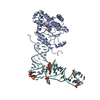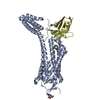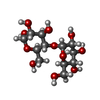[English] 日本語
 Yorodumi
Yorodumi- PDB-6pgq: Crystal structure of N-glycosylated human calcitonin receptor ext... -
+ Open data
Open data
- Basic information
Basic information
| Entry | Database: PDB / ID: 6pgq | |||||||||
|---|---|---|---|---|---|---|---|---|---|---|
| Title | Crystal structure of N-glycosylated human calcitonin receptor extracellular domain in complex with salmon calcitonin (22-32) | |||||||||
 Components Components |
| |||||||||
 Keywords Keywords |  SIGNALING PROTEIN / SIGNALING PROTEIN /  class B GPCR / class B GPCR /  GlcNAc GlcNAc | |||||||||
| Function / homology |  Function and homology information Function and homology information calcitonin receptor binding / calcitonin receptor binding /  calcitonin binding / amylin receptor complex 1 / amylin receptor complex 2 / cross-receptor inhibition within G protein-coupled receptor heterodimer / amylin receptor complex 3 / amylin receptor activity / calcitonin binding / amylin receptor complex 1 / amylin receptor complex 2 / cross-receptor inhibition within G protein-coupled receptor heterodimer / amylin receptor complex 3 / amylin receptor activity /  calcitonin receptor activity / calcitonin receptor activity /  calcitonin gene-related peptide receptor activity / amylin receptor signaling pathway ... calcitonin gene-related peptide receptor activity / amylin receptor signaling pathway ... calcitonin receptor binding / calcitonin receptor binding /  calcitonin binding / amylin receptor complex 1 / amylin receptor complex 2 / cross-receptor inhibition within G protein-coupled receptor heterodimer / amylin receptor complex 3 / amylin receptor activity / calcitonin binding / amylin receptor complex 1 / amylin receptor complex 2 / cross-receptor inhibition within G protein-coupled receptor heterodimer / amylin receptor complex 3 / amylin receptor activity /  calcitonin receptor activity / calcitonin receptor activity /  calcitonin gene-related peptide receptor activity / amylin receptor signaling pathway / positive regulation of adenylate cyclase activity / Calcitonin-like ligand receptors / negative regulation of ossification / calcitonin gene-related peptide receptor activity / amylin receptor signaling pathway / positive regulation of adenylate cyclase activity / Calcitonin-like ligand receptors / negative regulation of ossification /  sperm capacitation / positive regulation of protein kinase A signaling / response to amyloid-beta / positive regulation of calcium-mediated signaling / response to glucocorticoid / regulation of mRNA stability / regulation of cytosolic calcium ion concentration / activation of adenylate cyclase activity / sperm capacitation / positive regulation of protein kinase A signaling / response to amyloid-beta / positive regulation of calcium-mediated signaling / response to glucocorticoid / regulation of mRNA stability / regulation of cytosolic calcium ion concentration / activation of adenylate cyclase activity /  ossification / osteoclast differentiation / acrosomal vesicle / adenylate cyclase-activating G protein-coupled receptor signaling pathway / ossification / osteoclast differentiation / acrosomal vesicle / adenylate cyclase-activating G protein-coupled receptor signaling pathway /  cilium / cilium /  hormone activity / hormone activity /  amyloid-beta binding / positive regulation of cytosolic calcium ion concentration / G alpha (s) signalling events / positive regulation of phosphatidylinositol 3-kinase/protein kinase B signal transduction / cell surface receptor signaling pathway / positive regulation of ERK1 and ERK2 cascade / amyloid-beta binding / positive regulation of cytosolic calcium ion concentration / G alpha (s) signalling events / positive regulation of phosphatidylinositol 3-kinase/protein kinase B signal transduction / cell surface receptor signaling pathway / positive regulation of ERK1 and ERK2 cascade /  axon / positive regulation of gene expression / axon / positive regulation of gene expression /  extracellular space / extracellular region / extracellular space / extracellular region /  plasma membrane plasma membraneSimilarity search - Function | |||||||||
| Biological species |   Escherichia coli (E. coli) Escherichia coli (E. coli)  Homo sapiens (human) Homo sapiens (human) | |||||||||
| Method |  X-RAY DIFFRACTION / X-RAY DIFFRACTION /  SYNCHROTRON / SYNCHROTRON /  MOLECULAR REPLACEMENT / Resolution: 2.85 Å MOLECULAR REPLACEMENT / Resolution: 2.85 Å | |||||||||
 Authors Authors | Lee, S. / Pioszak, A.A. | |||||||||
| Funding support |  United States, 2items United States, 2items
| |||||||||
 Citation Citation |  Journal: J.Mol.Biol. / Year: 2020 Journal: J.Mol.Biol. / Year: 2020Title: Calcitonin Receptor N-Glycosylation Enhances Peptide Hormone Affinity by Controlling Receptor Dynamics. Authors: Lee, S.M. / Jeong, Y. / Simms, J. / Warner, M.L. / Poyner, D.R. / Chung, K.Y. / Pioszak, A.A. | |||||||||
| History |
|
- Structure visualization
Structure visualization
| Structure viewer | Molecule:  Molmil Molmil Jmol/JSmol Jmol/JSmol |
|---|
- Downloads & links
Downloads & links
- Download
Download
| PDBx/mmCIF format |  6pgq.cif.gz 6pgq.cif.gz | 207.6 KB | Display |  PDBx/mmCIF format PDBx/mmCIF format |
|---|---|---|---|---|
| PDB format |  pdb6pgq.ent.gz pdb6pgq.ent.gz | 168.2 KB | Display |  PDB format PDB format |
| PDBx/mmJSON format |  6pgq.json.gz 6pgq.json.gz | Tree view |  PDBx/mmJSON format PDBx/mmJSON format | |
| Others |  Other downloads Other downloads |
-Validation report
| Arichive directory |  https://data.pdbj.org/pub/pdb/validation_reports/pg/6pgq https://data.pdbj.org/pub/pdb/validation_reports/pg/6pgq ftp://data.pdbj.org/pub/pdb/validation_reports/pg/6pgq ftp://data.pdbj.org/pub/pdb/validation_reports/pg/6pgq | HTTPS FTP |
|---|
-Related structure data
- Links
Links
- Assembly
Assembly
| Deposited unit | 
| ||||||||
|---|---|---|---|---|---|---|---|---|---|
| 1 |
| ||||||||
| Unit cell |
|
- Components
Components
-Protein / Protein/peptide , 2 types, 2 molecules AB
| #1: Protein | Mass: 54078.906 Da / Num. of mol.: 1 Source method: isolated from a genetically manipulated source Source: (gene. exp.)   Escherichia coli (E. coli), (gene. exp.) Escherichia coli (E. coli), (gene. exp.)   Homo sapiens (human) Homo sapiens (human)Gene: malE, CALCR / Cell line (production host): HEK293S GnTI- / Production host:   Homo sapiens (human) / References: UniProt: A0A0A8UN35, UniProt: P30988 Homo sapiens (human) / References: UniProt: A0A0A8UN35, UniProt: P30988 |
|---|---|
| #2: Protein/peptide |  Mass: 1149.216 Da / Num. of mol.: 1 / Source method: obtained synthetically / Source: (synth.)  |
-Sugars , 2 types, 4 molecules 
| #3: Polysaccharide | alpha-D-glucopyranose-(1-4)-alpha-D-glucopyranose / alpha-maltose |
|---|---|
| #4: Sugar |  N-Acetylglucosamine N-Acetylglucosamine |
-Non-polymers , 2 types, 3 molecules 


| #5: Chemical | ChemComp-ACT /  Acetate Acetate |
|---|---|
| #6: Water | ChemComp-HOH /  Water Water |
-Details
| Has ligand of interest | Y |
|---|
-Experimental details
-Experiment
| Experiment | Method:  X-RAY DIFFRACTION / Number of used crystals: 1 X-RAY DIFFRACTION / Number of used crystals: 1 |
|---|
- Sample preparation
Sample preparation
| Crystal | Density Matthews: 4.59 Å3/Da / Density % sol: 73.22 % |
|---|---|
Crystal grow | Temperature: 293 K / Method: vapor diffusion, hanging drop / pH: 4.7 Details: 1.94M Ammonium sulfate, 0.1M Sodium acetate, 15% Ethylene glycol |
-Data collection
| Diffraction | Mean temperature: 100 K / Serial crystal experiment: N |
|---|---|
| Diffraction source | Source:  SYNCHROTRON / Site: SYNCHROTRON / Site:  APS APS  / Beamline: 21-ID-F / Wavelength: 0.97872 Å / Beamline: 21-ID-F / Wavelength: 0.97872 Å |
| Detector | Type: RAYONIX MX300-HS / Detector: CCD / Date: Aug 9, 2017 |
| Radiation | Protocol: SINGLE WAVELENGTH / Monochromatic (M) / Laue (L): M / Scattering type: x-ray |
| Radiation wavelength | Wavelength : 0.97872 Å / Relative weight: 1 : 0.97872 Å / Relative weight: 1 |
| Reflection | Resolution: 2.85→50 Å / Num. obs: 24107 / % possible obs: 99 % / Redundancy: 9.3 % / Net I/σ(I): 21.24 |
| Reflection shell | Resolution: 2.85→2.9 Å / Num. unique obs: 1167 |
- Processing
Processing
| Software |
| ||||||||||||||||||||||||||||||||||||||||||||||||||||||||||||||||||||||||||||||||||||||||||||||||||||
|---|---|---|---|---|---|---|---|---|---|---|---|---|---|---|---|---|---|---|---|---|---|---|---|---|---|---|---|---|---|---|---|---|---|---|---|---|---|---|---|---|---|---|---|---|---|---|---|---|---|---|---|---|---|---|---|---|---|---|---|---|---|---|---|---|---|---|---|---|---|---|---|---|---|---|---|---|---|---|---|---|---|---|---|---|---|---|---|---|---|---|---|---|---|---|---|---|---|---|---|---|---|
| Refinement | Method to determine structure : :  MOLECULAR REPLACEMENT / Resolution: 2.85→48.45 Å / Cor.coef. Fo:Fc: 0.956 / Cor.coef. Fo:Fc free: 0.936 / SU B: 28.683 / SU ML: 0.233 / Cross valid method: THROUGHOUT / σ(F): 0 / ESU R: 0.406 / ESU R Free: 0.269 MOLECULAR REPLACEMENT / Resolution: 2.85→48.45 Å / Cor.coef. Fo:Fc: 0.956 / Cor.coef. Fo:Fc free: 0.936 / SU B: 28.683 / SU ML: 0.233 / Cross valid method: THROUGHOUT / σ(F): 0 / ESU R: 0.406 / ESU R Free: 0.269 Details: HYDROGENS HAVE BEEN ADDED IN THE RIDING POSITIONS U VALUES : WITH TLS ADDED
| ||||||||||||||||||||||||||||||||||||||||||||||||||||||||||||||||||||||||||||||||||||||||||||||||||||
| Solvent computation | Ion probe radii: 0.8 Å / Shrinkage radii: 0.8 Å / VDW probe radii: 1.2 Å | ||||||||||||||||||||||||||||||||||||||||||||||||||||||||||||||||||||||||||||||||||||||||||||||||||||
| Displacement parameters | Biso max: 160.85 Å2 / Biso mean: 80.839 Å2 / Biso min: 48.25 Å2
| ||||||||||||||||||||||||||||||||||||||||||||||||||||||||||||||||||||||||||||||||||||||||||||||||||||
| Refinement step | Cycle: final / Resolution: 2.85→48.45 Å
| ||||||||||||||||||||||||||||||||||||||||||||||||||||||||||||||||||||||||||||||||||||||||||||||||||||
| Refine LS restraints |
| ||||||||||||||||||||||||||||||||||||||||||||||||||||||||||||||||||||||||||||||||||||||||||||||||||||
| LS refinement shell | Resolution: 2.853→2.927 Å / Rfactor Rfree error: 0 / Total num. of bins used: 20
| ||||||||||||||||||||||||||||||||||||||||||||||||||||||||||||||||||||||||||||||||||||||||||||||||||||
| Refinement TLS params. | Method: refined / Refine-ID: X-RAY DIFFRACTION
| ||||||||||||||||||||||||||||||||||||||||||||||||||||||||||||||||||||||||||||||||||||||||||||||||||||
| Refinement TLS group |
|
 Movie
Movie Controller
Controller











 PDBj
PDBj










